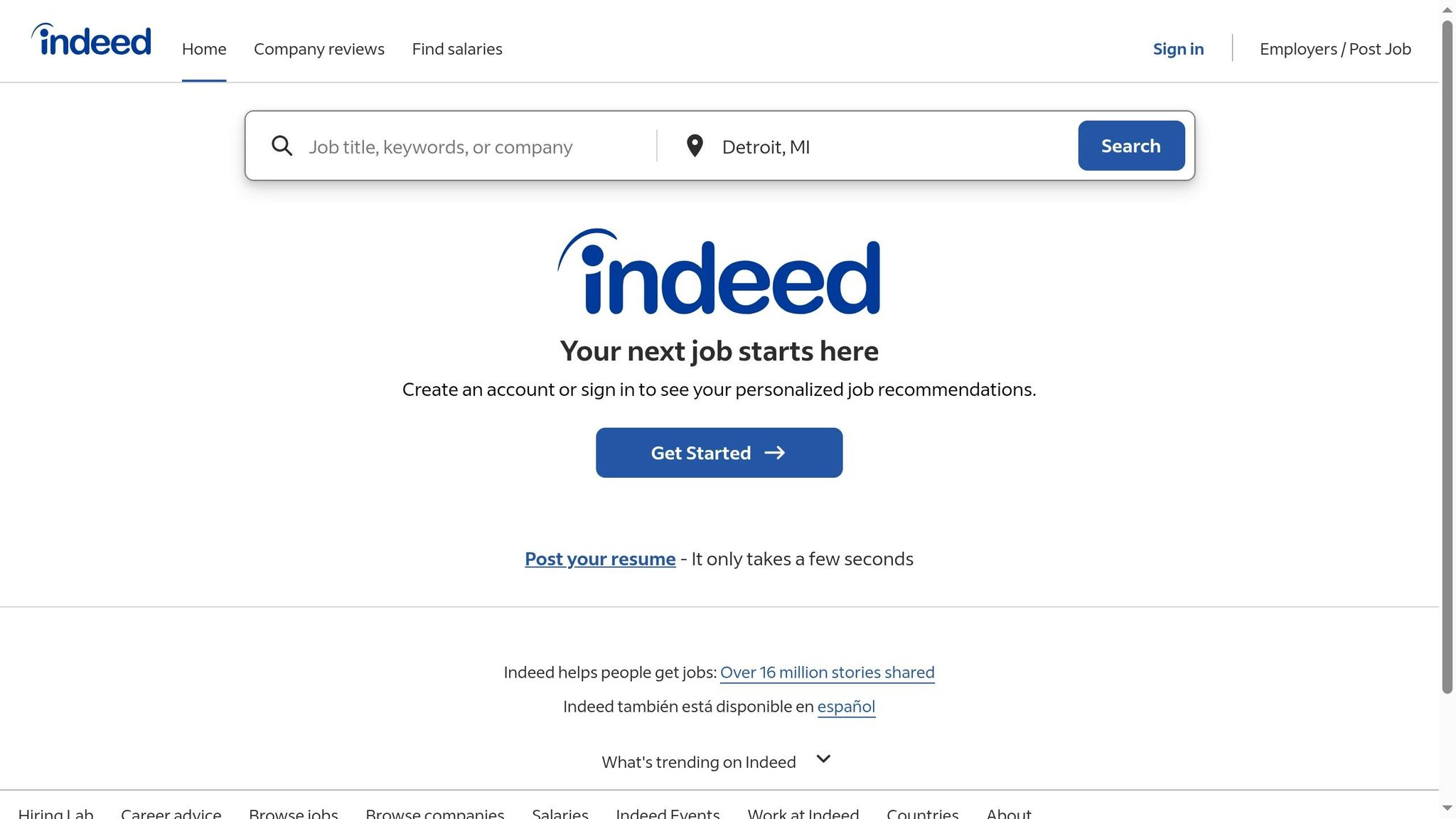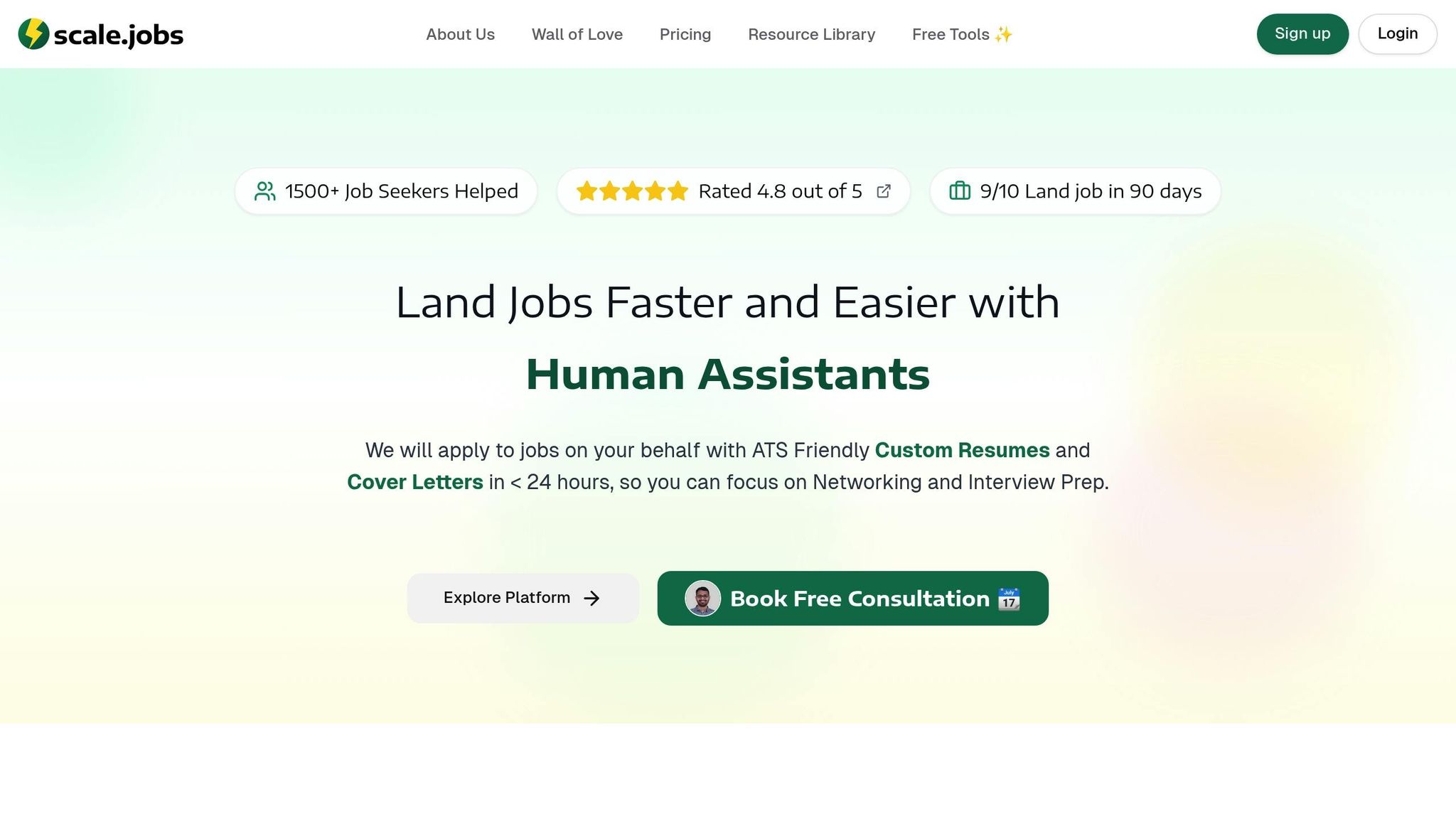Testing ATS Resumes on Indeed
Learn how to optimize your resume for Applicant Tracking Systems (ATS) on Indeed to increase your chances of getting noticed by recruiters.

75% of qualified resumes get rejected by ATS systems. Why? Formatting issues, missing keywords, and poor optimization. Most Fortune 500 companies - and a growing number of smaller businesses - use ATS to screen resumes. To ensure your resume gets seen by recruiters, you need to focus on:
- ATS-friendly formatting: Simple layouts, standard fonts, no images, and clear section headings.
- Keyword optimization: Use job-specific terms and include both full phrases and abbreviations (e.g., "Search Engine Optimization (SEO)").
- Testing your resume: Use tools like Indeed's built-in scanner or free ATS checkers like Jobscan and Resume Worded to identify issues.
Platforms like Indeed also integrate directly with ATS systems, making compatibility even more critical. A tailored, ATS-ready resume can significantly boost your chances of landing an interview.
Quick Tip: Avoid tables, graphics, or headers that ATS might misread. Stick to clean, readable formats and save your resume as a .docx or PDF file.
A Guide to Applicant Tracking Systems | Resume Tips | Indeed Career Tips

How ATS and Indeed Screen Resumes
Getting past the first hurdle in the hiring process often means understanding how Applicant Tracking Systems (ATS) work. These tools act as digital gatekeepers, scanning resumes before they ever reach a recruiter. Below, we’ll break down how ATS works and how Indeed incorporates it into its hiring ecosystem.
What Is an Applicant Tracking System (ATS)?
An Applicant Tracking System (ATS) is software designed to simplify and streamline the hiring process. It scans resumes for key details like education, skills, work experience, and certifications, then compares them to the job description. The system looks for specific keywords tied to the role’s requirements - skills, qualifications, degrees - and uses this information to rank resumes. Those that align most closely with the job criteria are prioritized for review by recruiters.
How Indeed Uses ATS for Job Applications
Indeed has built a robust network that connects with over 300 ATS platforms worldwide, ensuring a smooth link between job seekers and employers. When you apply for a job on Indeed, your application often moves directly into the employer’s ATS through Indeed’s ATS Sync technology. This automated process eliminates manual data entry and reduces the risk of errors during data transfer.
The benefits of this integration are clear. Jobs featuring the Indeed Apply option get 20% more clicks than those without, and the Easy Apply feature can lead to up to five times more completed applications. For instance, Rentokil, a pest control company, integrated its Workday ATS with Indeed’s ATS Sync and saw a 233% increase in applications and a 14.3% rise in hires through Indeed.
"Indeed is Workable's most activated integration with our customer base", says Trevor Schueren, Senior Product Partnerships Manager at Workable. "Looking at our data as of September 2023, we see Indeed is the #1 source of hires made in the US."
Indeed also uses screening questions and filters alongside ATS technology to help employers identify the most qualified candidates. These tools ensure that only serious and relevant applicants make it through the initial stages, saving time for recruiters.
Why ATS Compatibility Matters for Job Seekers
Nearly all recruiters - over 99.7% - use ATS filters to narrow down candidate pools. These filters often focus on skills, education, job titles, certifications, and years of experience. If your resume doesn’t include the right keywords or follow a clear format, it may never make it to a recruiter’s desk.
Formatting plays a big role here. ATS systems need simple, clean resume layouts to accurately scan and process content. Using complex elements like images, icons, tables, or unusual fonts can confuse the system, causing it to overlook important details.
Keyword strategy is another critical factor. Use both full terms and their abbreviations (e.g., "Search Engine Optimization (SEO)") to increase your chances of matching different search queries. However, avoid overloading your resume with keywords - integrate them naturally into your content.
"Remember that the ATS is scanning resumes to find qualified applicants based on keywords from the job description. Use a simplified resume format and tailor your content to the role that you're applying for so that you can ensure that you qualify and also that an ATS and recruiters can see it too", advises resume expert Sinéad.
How to Make Your Resume ATS-Ready for Indeed
With rejection rates hovering around 75% for qualified candidates and the widespread use of Applicant Tracking Systems (ATS), getting your resume format right is absolutely crucial when applying on platforms like Indeed. These tips address the challenges of ATS filtering and help ensure your resume gets noticed.
Add Job-Specific Keywords
ATS optimization starts with using the right keywords. Considering that 99.7% of recruiters use ATS filters, and 76.4% filter by skills while 55.3% filter by job titles, your resume needs to match the language of the job posting.
Start by analyzing the job description for key responsibilities, qualifications, and duties. Including the exact job title in your resume can make a big difference - candidates who do this are 10.6 times more likely to land an interview. Use the same phrasing as the company when it aligns with your experience.
Aim to include 25–30 targeted keywords throughout your resume, covering sections like your summary, work experience, skills, and education. Use both full terms and their abbreviations. For example, write "Search Engine Optimization (SEO)" to ensure you’re covered for different search variations. Research shows that 88% of employers rely on hiring systems that may filter out qualified candidates if their resumes don’t match the job description exactly. This makes precise keyword usage a game-changer.
If you’re unsure which keywords to include, search online for "[your industry] resume keywords" to find relevant terms. Additionally, incorporate role-specific keywords like the company name or job title, but make sure they flow naturally in your sentences - forcing keywords into your text can backfire. Once your keywords are in place, the next step is to focus on ATS-friendly formatting.
Format Your Resume for ATS Systems
When it comes to ATS compatibility, simplicity is key. ATS software scans text, so complex formatting can lead to errors. Avoid using images, icons, tables, columns, charts, or graphics, as these elements can shift or obscure your content, making it harder for the system to read. Instead, organize information with clean, bulleted lists and emphasize important points using bold text, rather than experimenting with multiple fonts or sizes.
Stick to standard fonts like Arial, Calibri, or Times New Roman in a 10–12 point size. Choose either a chronological or hybrid resume format, as both work well with ATS. Chronological resumes focus on listing work experience in reverse order, while hybrid formats blend a skills section with chronological job history. Avoid functional resumes, which highlight skills but lack detailed work history - ATS systems often struggle with these.
Save your resume as a .docx or PDF file, and make sure all text is left-aligned. This format is easiest for ATS and human reviewers to process. Keep your contact details in the main body of the document, not in headers or footers, as ATS software may skip over those areas. Use conventional margins to ensure all text stays within the readable area. After formatting your resume, focus on using standard section headings for clarity.
Use Standard Section Headings
ATS systems depend on clear, recognizable headings to organize and categorize your information correctly. Creative or unconventional headings can confuse the software, leading to misplaced or overlooked details. Stick with familiar headings like "Professional Experience", "Work Experience", "Skills", "Education", "Technical Skills", and "Certifications."
To create a clear hierarchy, make section headings bold and slightly larger than the body text, but avoid using multiple fonts or sizes throughout the document. Consistent formatting helps ATS software navigate your resume and extract the necessary details. Avoid using overly creative alternatives like "My Journey" for "Work Experience" or "What I Bring" for "Skills", as these can confuse the system and prevent your qualifications from being properly recognized. Clear, standard headings ensure your resume makes it past the ATS and into the hands of a recruiter.
How to Test Your Resume's ATS Compatibility on Indeed
Once you've fine-tuned your resume's format and keywords, it's time to test how well it performs with Applicant Tracking Systems (ATS). This step helps you catch potential issues before submitting your applications. By following these testing methods, you can ensure your resume is ready to navigate Indeed's automated systems and beyond.
Test with Indeed's Built-In Tools
Indeed provides built-in ATS features that make it easy to test your resume. Start by uploading your resume to Indeed's resume database. The platform scans your document and flags any formatting issues, missing details, or readability problems.
Pay close attention to the preview of your resume. If you notice misaligned sections, jumbled text, or missing information, these are warning signs that ATS systems may struggle to read your resume properly. The preview shows exactly how your resume will appear to employers, giving you a clear idea of what needs to be fixed.
Additionally, Indeed offers suggestions to improve your resume's visibility in search results. These tips often align with general ATS guidelines, such as adding relevant skills, refining job titles, or incorporating more targeted keywords. Be sure to address any alerts about file format compatibility or section organization, as these can directly impact how ATS systems interpret your resume.
Use Free ATS Resume Checkers
Several free tools can help you analyze your resume's compatibility with ATS systems. Here are some popular options:
- Scale.jobs: This tool provides a detailed analysis of your resume, checking for formatting errors, keyword optimization, and structural issues. It offers actionable feedback to help you make improvements without requiring a subscription.
- Jobscan: Known for its thorough analysis, Jobscan compares your resume to specific job descriptions, providing a compatibility score and highlighting missing keywords.
- Resume Worded: This platform evaluates your resume for impact, style, brevity, and skills alignment. It also assesses whether your achievements are measurable and if your language fits industry expectations. While full results require a free account, the basic insights can be very helpful.
Other tools like Kickresume and EnhanCV also provide checks for formatting and keyword usage. For the best results, paste both your resume and the job description you're targeting into these tools. They’ll highlight missing keywords and show how well your experience matches the job requirements, often giving you a percentage score to track your progress.
Compare Results from Multiple Tools
Using multiple ATS checkers is a smart way to get a well-rounded view of your resume's compatibility. Each tool operates with its own algorithm and criteria, so testing across several platforms helps you spot recurring issues.
For example, tools like SkillSyncer evaluate job title alignment, word count, and the impact of your statements, while My Perfect Resume focuses on customization, grammar, and measurable results. By consolidating the feedback from different platforms, you can identify patterns and prioritize the most critical fixes.
"There is no more sure-fire way to get your resume lost in an ATS than to complicate your resume with graphics, tables, and creative fonts. You'll want to, but don't do it." - Jazlyn Unbedacht, Resume Writer & LinkedIn Optimization
Keep in mind that some tools may prompt you to pay for detailed feedback. Focus on platforms that offer substantial insights for free, and use their combined results to create a solid improvement plan. Pay special attention to issues flagged by multiple tools - these are the areas that need the most attention to maximize your resume's ATS compatibility.
Scale.jobs vs Competitors: Best ATS Resume Testing Tools

Optimizing your resume for Indeed's ATS is essential if you want recruiters to notice your application. With so many ATS testing tools claiming to help, it’s vital to choose one that truly delivers. Let’s see how Scale.jobs stacks up against popular competitors like Jobscan, Rezi.ai, and Find My Profession, so you can decide which tool fits your job search strategy best.
Scale.jobs vs Major Competitors Comparison
The ATS testing market is packed with options, each offering its own advantages and drawbacks. Here’s a closer look at the major players:
- Jobscan: Known for its strong keyword matching and ATS compatibility analysis, Jobscan boasts a 4.7/5 rating from over 800 reviews. While it’s great for resume tailoring, users have noted its limited design capabilities and a focus primarily on the U.S. job market.
- Rezi.ai: This tool shines when it comes to optimizing resumes for large corporations, helping applicants bypass automated filters. At $29/month for unlimited applications, it’s a budget-friendly choice. However, it lacks the human touch to catch more nuanced errors.
- Find My Profession: Taking a unique approach, this service offers reverse recruiting with an impressive 98% success rate. But with prices ranging from $1,499 to $3,999 for 100 monthly applications, it’s a pricey option that may not suit most job seekers.
Here’s a quick side-by-side comparison of Scale.jobs and its competitors:
| Service | Monthly Applications | Price Range | Key Strength | Main Weakness |
|---|---|---|---|---|
| Find My Profession | 100 | $1,499–$3,999 | Reverse recruiting, 98% success rate | High cost, low application volume |
| Scale.jobs | 250–1,000+ | $199–$1,099 | Transparent, human-powered process | Limited market presence |
| Rezi.ai | Unlimited | $29/month | Affordable, AI-powered | No human oversight |
| Jobscan | Varies | Premium required | Fast resume tailoring | Limited design options |
Why Scale.jobs Stands Out
What makes Scale.jobs different? It’s the combination of human oversight with smart automation. Unlike Jobscan, which focuses heavily on keyword analysis, or Rezi.ai, which relies entirely on AI, Scale.jobs assigns trained human virtual assistants to manage every application. This extra layer of human involvement helps avoid common issues like bot-flagging that can arise with fully automated tools.
Another standout feature is the platform’s transparency. With real-time WhatsApp updates and proof-of-work screenshots, you’ll always know the status of your applications. This clarity eliminates the uncertainty often associated with ATS processes.
Scale.jobs also breaks away from the subscription model. Instead of paying monthly fees like Rezi.ai or facing surprise renewals, you can opt for one-time campaign bundles. Plus, if you land a job earlier than expected, Scale.jobs offers pro-rata refunds, potentially saving you a lot in the long run.
Compatibility is another area where Scale.jobs excels. While tools like Jobscan focus on a narrow range of well-known ATS systems, Scale.jobs can manage applications across corporate ATS platforms, niche job boards, and even direct company websites.
To top it off, Scale.jobs includes a free toolkit packed with useful features like an ATS resume checker, cover letter generator, application tracker, salary predictor, and interview questions predictor. Instead of juggling multiple tools, you get everything you need in one place.
Lastly, for job seekers navigating visa requirements (H1B, F1, CPT, TN, O1, etc.), Scale.jobs offers tailored support. Its human assistants are well-versed in the complexities of immigration-related job searches, ensuring applications meet specific requirements that automated systems might miss.
Key Points for ATS Testing on Indeed
Making sure your resume is ATS-friendly on Indeed involves a mix of smart formatting, strategic keyword usage, and careful testing. Did you know that 75% of qualified candidates are rejected by ATS simply due to readability issues? That’s why it’s crucial to get this right.
Start with ATS-friendly formatting. Stick to standard fonts like Arial or Calibri, use 1-inch margins, and save your resume as a .docx file. Avoid flashy designs or unconventional elements. As one expert puts it:
"There is no more sure-fire way to get your resume lost in an ATS than to clutter your resume with graphics, tables, and creative fonts. You'll want to, but don't do it."
Next, focus on keyword optimization. Identify terms specific to the job you’re targeting, and include both acronyms and their full forms - like "Search Engine Optimization (SEO)." After adding these keywords, test their impact using free tools.
There are several free ATS checkers available, such as Jobscan, Resume Worded, and Enhancv. These tools analyze formatting and keyword usage, offering actionable feedback. For instance, Jobscan recommends aiming for a 75% match rate with the job description, though a match as low as 65% can still work for some roles.
If you’d rather skip the trial and error, services like Scale.jobs provide a free ATS resume checker along with human assistance for critical applications. This can be especially helpful for visa holders managing H1B, F1, or other immigration-related challenges.
Finally, remember that balance is key. Overloading your resume with keywords can hurt just as much as using too few. Aim for a natural flow when integrating terms. Considering that 99% of Fortune 500 companies rely on ATS, refining these techniques is crucial for ensuring your resume reaches real recruiters who can truly appreciate your skills.
FAQs
How can I make sure my resume is ATS-friendly when applying on Indeed?
To make sure your resume gets through Indeed's ATS (Applicant Tracking System), stick to straightforward formatting. Use standard headings like Education, Experience, and Skills. Steer clear of graphics, tables, or unusual fonts, as these can trip up the ATS and prevent your resume from being properly read.
Include keywords from the job description, especially those tied to the required skills and qualifications. Tailor your resume for each position by highlighting relevant achievements and mirroring the language used in the job posting. Tools like scale.jobs' ATS-compliant resume builder can help streamline the process, and their human experts can refine your resume to improve its chances of passing ATS scans. This way, your application is more likely to reach the hiring manager's desk.
What are the most common resume mistakes that lead to ATS rejection?
Common Resume Mistakes That Get Rejected by ATS
When it comes to Applicant Tracking Systems (ATS), even small missteps can lead to your resume being overlooked. Here are some frequent mistakes that could hurt your chances:
- Overly complex formatting: Using tables, text boxes, or images might look nice, but many ATS tools can’t read them properly. Stick to straightforward layouts.
- Inconsistent or unusual date formats: Mixing up date styles or using non-standard fonts can confuse the system.
- Typos and grammar errors: Even minor mistakes can make your resume seem unprofessional.
- Wrong file type: Unless stated otherwise, always submit your resume as a Word document (.doc or .docx). Many ATS platforms have trouble processing PDFs.
- Missing or misused keywords: If your resume doesn’t include the right keywords - or if they’re not placed in the right context - it may not match the job description effectively.
To boost your odds, keep your resume clean and simple, double-check for errors, and customize it with keywords that align with the job posting.
How can I check if my resume is ATS-compatible for jobs on Indeed?
When applying for jobs on Indeed, it's essential to ensure your resume is compatible with applicant tracking systems (ATS). These systems screen resumes for keywords, structure, and alignment with job descriptions, so optimizing your resume can significantly boost your chances of getting noticed.
There are several tools available to help with this. Resume checkers and ATS analyzers can review your resume and offer actionable feedback to refine its formatting and content. For example, platforms like scale.jobs provide free resources, including an ATS-friendly resume builder and detailed resume feedback, to help you tailor your applications and stand out in the job market.




![[UPDATED-2026] Job Search Strategies That Actually Work: Tips + Best Tools](/content/images/size/w600/2025/12/image-1764688576191.jpeg)